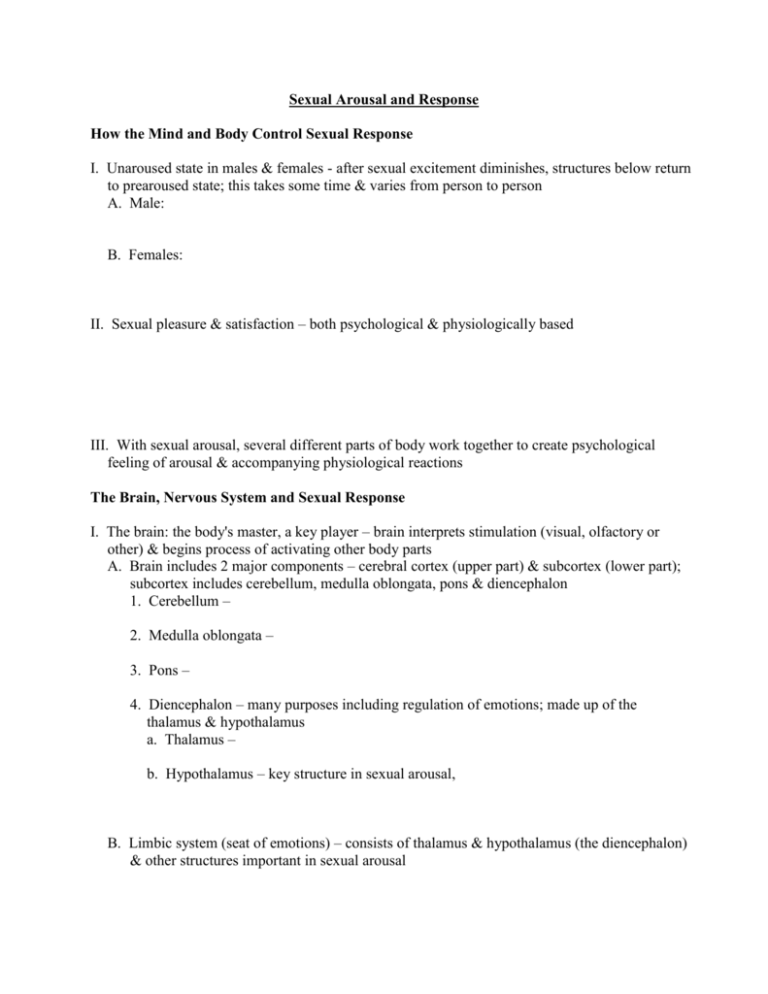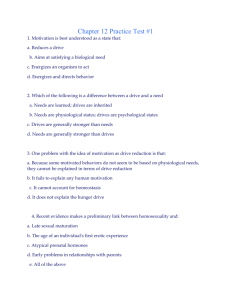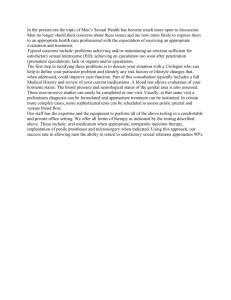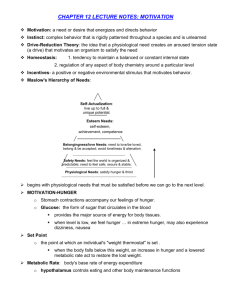
Sexual Arousal and Response
How the Mind and Body Control Sexual Response
I. Unaroused state in males & females - after sexual excitement diminishes, structures below return
to prearoused state; this takes some time & varies from person to person
A. Male:
B. Females:
II. Sexual pleasure & satisfaction – both psychological & physiologically based
III. With sexual arousal, several different parts of body work together to create psychological
feeling of arousal & accompanying physiological reactions
The Brain, Nervous System and Sexual Response
I. The brain: the body's master, a key player – brain interprets stimulation (visual, olfactory or
other) & begins process of activating other body parts
A. Brain includes 2 major components – cerebral cortex (upper part) & subcortex (lower part);
subcortex includes cerebellum, medulla oblongata, pons & diencephalon
1. Cerebellum –
2. Medulla oblongata –
3. Pons –
4. Diencephalon – many purposes including regulation of emotions; made up of the
thalamus & hypothalamus
a. Thalamus –
b. Hypothalamus – key structure in sexual arousal,
B. Limbic system (seat of emotions) – consists of thalamus & hypothalamus (the diencephalon)
& other structures important in sexual arousal
1. Connected to diencephalons & primarily concerned with emotions & their behavioral
expression
C. Cerebral cortex (gray matter) – controls higher order abstract functioning (language,
judgment); can also control more primitive areas of brain
D. Reticular activating system (RAS) – in past, cortical & subcortical functions considered to be
dichotomized; behavior was thought to be function of one area of brain or other
1. Now believed to be neurological connections between cortex & subcortex that feed
information back & forth
2. This network of nerves, the RAS, can be considered the connection between mind &
body; reticular body is a kind of two-way street
II. The brain & sexual response – if you encounter a sexual stimulus, message is passed to brain via
nerves; generalized no 2 people exactly the same so no 2 react exactly the same
A. Once reaching brain, message passes through RAS either from or to the limbic system &
thalamus
B. Next, hypothalamus is activated & in turn activates autonomic nervous system (ANS) &
endocrine system through messages sent via nerves or substances released into blood
III. Great deal of variation in sexual response, even though there are certain typical means of
responding to sexually stimulating stimuli
A. No 2 people exactly the same so no 2 people react exactly the same
B. Due to illness or injury, some typical responses may be precluded for some people
C. Some people have little control over apparently involuntary responses; others are able to
exercise some control
IV. Autonomic nervous system (ANS) – consists of sympathetic & parasympathetic nervous
systems; these subnervous systems connect to various parts of body through nerves
A. As sexually arousing stimuli are experienced, messages are sent via nerves to body parts,
instructing them to react
1. Heart rate increases, muscles tense, perspiration occurs, mind starts racing
2. Certain arteries are instructed to open (dilate) & allow more blood to flow through
3. Increase of blood to genital area is called engorgement; also creates pressure on walls of
vagina leading to vaginal lubrication
B. Muscles also contract as a result of messages sent through nerves that make up ANS
1. In men 2. In women V. Role of hormones in sexual arousal – sexually arousing stimulus activates endocrine system,
hormones secreted & changes in body occur; sexual hormones made in testes & ovaries
A. Testosterone (androgen made mostly in testes interstitial cells in men & ovaries in women
(although small amount made by adrenal glands); affects sexual interest (libido)
B. Some people turn to chemical aids – androstenedione (andro), which is marketed as dietary
supplement & thus not regulated by FDA
1. Athletes use it to help them recover from weight-training workouts; it is a steroid
hormone & close cousin of testosterone, so some use it to enhance sexual satisfaction
VI. Aphrodisiacs – named after Greek goddess of love Aphrodite; any substance that arouses
sexual desire and/or enhances sexual response; people search for safe & effective one
A. Spanish fly (canthardin) – results in irritation of urinary tract; it has led to substances that
make one horny (ground up rhinoceros horns or elephant tusks which do not work)
B. Even toxic substances have been tried to enhance sexual desire/response like amyl nitrate
1. Designed for use by heart patients to reduce chest pain – its container is popped open
when chest pain occurs (called poppers)
2. Became popular among some gay men as aphrodisiac because it facilitated anal
intercourse by relaxing anal sphincter muscle
C. Bupropion (antidepressant; acquired under brand name of Wellbutrin) & L-Dopa (used for
treating Parkinson's disease)
1. Both act on brain receptors that produce dopamine & so can increase libido
D. Alcohol & marijuana – if they work at all, they diminish judgment & make people feel less
stress about sex (good or bad)
1. Decrease in inhibitions may result in high-risk sexual behavior (vaginal/anal intercourse
without condom) that may lead to STI or cause unwanted pregnancy
2. Alcohol –
3. Marijuana –
E. Yohimbine hydrochloride (from sap of West African tree, the yohimbine tree) – has potential;
reported to aid some men with erectile dysfunction
1. Helps to achieve & maintain erection for long-enough period to engage in sexual
intercourse; does not work for all men with erectile dysfunction
F. Drugs that inhibit sexual desire also being looked at – used by military to diminish sexual
desire of soldiers & used in summer camps to control urges of teenagers
1. All potassium nitrate does is increase need to urinate; some people think that is enough to
interfere with sex
2. Some drugs do interfere with sexual response –
Masters & Johnson Sexual Response Cycle: Four Phases of Human Sexual Response
I. Excitement phase – sexual stimuli result in a number of specific changes in the bodies of men &
women
A. Changes that occur during this phase
1. Heart rate, blood pressure & muscle tension all increase
2. Blood engorges abdominal area, resulting in increase in penile & clitoral erection as well
as increase in size of labia minora, vagina, & nipples
B. Transudation – process resulting in vaginal lubrication
1. When female is sexually aroused, blood flows into area surrounding walls of vagina
(vasocongestion)
2. Pressure of increased blood causes seepage of moisture from spaces between cells
C. Phase may be short or last for several hours – the longer it lasts the more variability there is
1. Changes in penis & vagina vacillate over time in extended excitement phase; penis may
occasionally become less erect & vaginal lubrication may diminish periodically
2. Some people respond quickly; others need more time
II. Plateau phase – excitement becomes enhanced
A. Events during plateau phase - heart rate rises, blood pressure rises, muscle tension increases,
breathing is faster
1. Men –
2. Women –
B. Plateau phase usually lasts only a few minutes, but there are reports of more intense orgasms
in people who have purposely extended the plateau phase
1. Orgasm is not the necessary follow-up to plateau
III. Orgasm phase
A. For males, it consists of 2 stages: emission stage & expulsion stage
1. Emission stage – muscular contraction of vas deferens, seminal vesicles & prostate gland
create buildup of semen in urethral bulb located at base of penis
a. At same time, external urethral sphincter contracts, holding in semen &
2. Expulsion stage
a. Internal urethral sphincter remains contracted so urine & semen do not mix, but…
B. Again experience varies from person to person
1. Males generally experience intense sensations during first couple of contractions & less
sensation during later contractions
a. Degree of sensation appears to be related to amount of sperm expelled
2. Females – orgasm phase also consists of muscular contractions & intense sensations
a. Pelvic muscles surrounding vagina in particular those of orgasmic platform, contract 3
– 15 times, each contraction lasting<1 sec
b. Other weaker & slower contractions follow; in addition, uterine contractions occur
beginning from top of uterus & proceeding downward
3. Both males & females – other changes occur during orgasm
a. Heart rate increases dramatically, blood pressure rises, breathing becomes rapid &
shallow; muscles throughout body contract; perspiration is evident
b. Intense, pleasant psychological feeling associated with the release of sexual tension
afforded by orgasm occurs
IV. Resolution phase – return to unaroused state
A. Males – drop in penis size as erection is lost; 2 stages: first lasts ~1 min as blood exits
corpora cavernosa; second lasts several minutes as blood leaves corpus spongiosum
1. Results from opening of veins in penis, allowing blood to be removed from area
B. Women – muscles relax; uterus, vagina & labia return to unaroused positions & color; clitoris
returns from under clitoral hood & sex flush dissipates
1. After return of uterus to normal position, cervix lowers into seminal pool
C. Both males & females – heart rate, blood pressure & breathing rate return to normal; muscle
tension decreases
1. Males experience refractory (recovery) period during which they cannot have another
orgasm; may be several minutes long for young men but usually longer in older males
V. Overall view of Sexual Response Cycles
A. Males – start with excitement phase, move to plateau then to orgasm & finally to resolution
phase
1. Either move through resolution to prearoused state or to a refractory period (part of
resolution state)
B. Females – more varied in their sexual responses
1. 1st pattern –
2. 2nd pattern –
3. 3rd pattern –
Other Theoretical Models of Sexual Response
I. Kaplan's Triphasic Model – proposed by noted sex therapist Helen Singer Kaplan (1974)
A. A biphasic model conceptualizing human sexual response as having 2 identifiable phases
1. Vasocongestion of genitals
2. Reflexive muscular contractions of orgasm
B. Argued that 2 phases were each controlled by different part of NS, both part of ANS
1. Vasocongestion –
2. Orgasm –
C. Explained that different structures are involved in each of these phases: blood vessels for
vasocongestion & muscles for orgasm
1. Interference with vasocongestion results in male erection problems; different sexual
dysfunctions (premature & retarded ejaculation) were result of orgasm impairment
D. Since vasocongestion problems were quite different from & mutually exclusive with
orgasm problems, Kaplan believed biphasic model to be correct
E. Over the years, the biphasic model evolved into a triphasic model (Kaplan, 1979) consisting
of desire phase, excitement phase & resolution phase
1. Found that sexual dysfunctions fall into one of these 3 categories & that they are
separate & distinct
F. Sexual desire is not always present during sexual activity
II. (Bernie) Zilbergeld & (Carol) Ellison's Model (1980) – consists of 5 components
A. Concerned that Masters & Johnson ignored cognitive & subjective aspects of sexual
response, while focusing exclusively on physiological aspects
1. Defined sexual desire as frequency with which a person wants to engage in sexual
activity
2. Defined sexual arousal as how excited one becomes during sexual activity
B. The 5 components of the model: interest (desire), arousal, physiological readiness (erection,
vaginal lubrication), orgasm, satisfaction (ones evaluation of how one feels)
C. This model allows for sexual dysfunctions that pertain to desire although other responses
may be normal
III. These other two models are more inclusive of psychological aspects of sexual response
whereas Masters & Johnson are more concerned with physiological aspects
Erotic Stimulus Pathway (ESP) Theory
I. Erotic Stimulus Pathway Theory proposed by David M. Reed (Haffner & Stayton, 1998) –
enhances our understanding & ability to treat sexual dysfunctions
II. Seduction phase – person learns how to get aroused sexually & how to attract someone else
sexually; seduction translates into memories & rituals
A. Adolescents may spend much time on personal appearance, clothes choice & mannerisms, all
of which can enhance positive self-esteem if adolescents like the way they feel
B. These seductive techniques are stored in memory & can be activated later in life
III. Sensations phase – different senses can enhance sexual excitement & ideally prolong plateau
phase
A. Early experiences of touch
B. Sense of vision
C. Hearing loved one
D. Smell of loved one
E. Taste
IV. Surrender phase – orgasm is psychophysiological surprise; psychodynamic issues surrounding
orgasm are power & control
A. Those with orgasmic dysfunction may be in power struggle with themselves or with their
partners or with the messages received about sex
V. Reflection phase – meaning is given to the experience
A. Whether sexual experience interpreted as "+" or "-" may determine desire for later sexual
activity at least with that partner under those circumstances or with those behaviors
Orgasm
I. Orgasmic sensation – feelings accompanying orgasm are quite different from the physiological
responses & may even contradict what we know is occurring physiologically
A. Woman might experience a physiologically intense orgasm (~12 measurable muscular
contractions) but report it to be mild or vice versa with 4 contractions
1. Reason for discrepancy is that sexual experience is interpreted by the mind as well as
body
B. Generally, orgasm sensations are experienced similarly by males & females, but there are
exceptions
1. Women – highly pleasurable feeling that usually begins at clitoris but quickly spreads to
whole pelvic area
2. Men – experience is highly pleasurable; usually experience warmth, pressure &
sometimes throbbing during moment when they have reached point of no return
C. Similarity of male & female orgasms demonstrated in 2 studies of college students – Proctor,
Wagner & Butler (1974) & Wiest (1977)
1. Students wrote description of their orgasms & descriptions were analyzed by experts
II. Controversies about orgasm: types of orgasm – experts disagree about types
A. Early 1900s – Freud theorized there were 2 types of female orgasm: clitoral & vaginal
1. Saw clitoral orgasm as immature sexual response that women outgrew; thought it was
stunted penis
2. When theory was operationalized, surgical clitoris removal (clitoridectomy) was done on
girls who were too clitorally focused as determined by their clitoral masturbation
B. Masters & Johnson (1966) – identified only 1 type of orgasm
1. Regardless of stimulation point (clitoris or vagina) or method (penile insertion or vibrator),
they reported same physiological occurrences during orgasm
C. Hite (1976) – validated above results; noncoital orgasms more intense than coital; also found
coital orgasm to be more diffused through body than locally intense clitoral one
D. Singer & Singer (1972) – 3 distinct orgasm types: vulval, uterine & blended; included
emotional satisfaction as a consideration; no one form better than others, just different
1. Vulval orgasm –
2. Uterine orgasm –
3. Blended orgasm –
E. Orgasm is not just physiological response to stimulation; the human mind & human body
interact; it is impossible to separate influence of the two; without mind, no orgasm
III. Recognizing orgasms – sometimes males can have orgasm without ejaculate (men with prostate
disease & in prepubescent boys
A. Implications of questions about recognizing female orgasm
1. Expresses concern for woman's sexual satisfaction – on surface, this appears to be healthy;
however, often more related to man's ego than to woman's satisfaction
B. Faking orgasm is dishonest & deceitful & may lead partner to believe something unsatisfying
was great & should be repeated next time
1. If what partner does is pleasurable but does not lead to orgasm, it might be enough
C. Men also prone to faking orgasm if unable to achieve one
1. Man drinking alcohol who can't reach orgasm may feel threatened by how this might be
interpreted by partner (dysfunctional, less than real man, partner not attractive, etc.)
D. Faking orgasm should be discussed candidly with partner —> could make relationship closer
IV. Simultaneous orgasm – difficult to achieve, but focusing on this can detract from enjoyment of
experience








